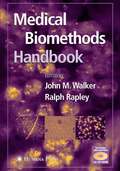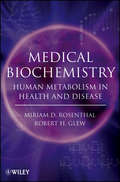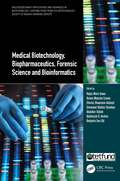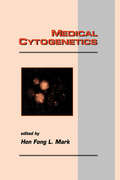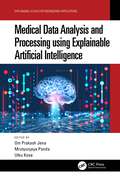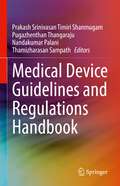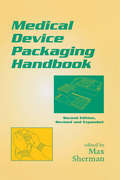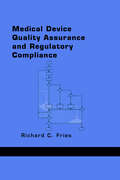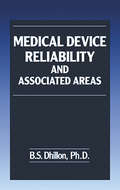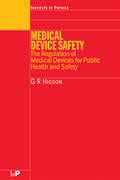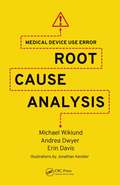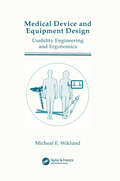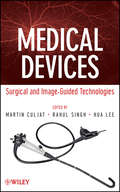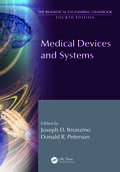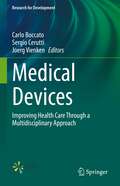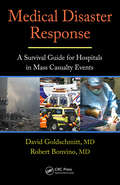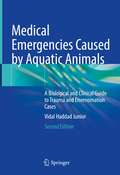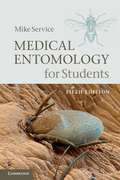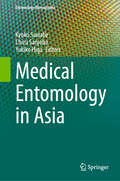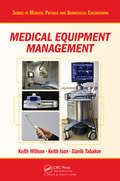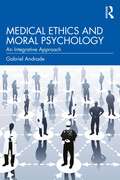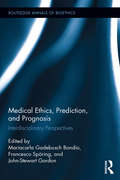- Table View
- List View
Medical BioMethods Handbook
by Ralph Rapley John M. WalkerJohn Walker and Ralph Rapley have collected a wide-ranging group of molecular and biochemical techniques that are the most frequently used in medical and clinical research, especially diagnostics. The authors-well-established investigators who run their own research programs and use the methods on a regular basis-outline the practical procedures for using them and describe a variety of pertinent applications. Among the technologies presented are southern and western blotting, electrophoresis, PCR, cDNA and protein microarrays, liquid chromatography, in situ hybridization, karyotyping, flow cytometry, bioinformatics, genomics, and ribotyping. The applications include assays for mutation detection, mRNA analysis, chromosome translocations, inborn errors of metabolism, protein therapeutics, and gene therapy.
Medical Biochemistry: Human Metabolism in Health and Disease
by Miriam D. Rosenthal Robert H. GlewMetabolism includes various pathways of chemical reactions; understanding these pathways leads to an improved knowledge of the causes, preventions, and cures for human diseases. Medical Biochemistry: Human Metabolism in Health and Disease provides a concise yet thorough explanation of human metabolism and its role in health and diseases. Focusing on the physiological context of human metabolism without extensive consideration of the mechanistic principles of underlying enzymology, the books serves as both a primary text and resource for students and professional in medical, dental, and allied health programs.
Medical Biotechnology, Biopharmaceutics, Forensic Science and Bioinformatics (Multidisciplinary Applications and Advances in Biotechnology)
by Hajiya Mairo InuwaThis book covers a range of topics on exploiting Nigeria’s mega biodiversity for food security and health; DNA forensic science and its applications; medical biotechnology and biopharmaceutics; medicinal and underutilized plants; impact and mitigation of antibiotic resistance; bioinformatics applications; medical insect biotechnology; etc. The book will be useful reference material for the scientists and researchers working in the fields of nutraceuticals, molecular diagnostics and DNA forensics, biopharmaceuticals and medical biotechnology, nanotechnology, antimicrobials from indigenous plant species, bioinformatics, etc. Emphasizes recent advances in biotechnologies that will help in tackling emerging global health challenges Provides detailed information on how to harness indigenous bioresources including microorganisms and plants for healthcare delivery Introduces new frontiers in the areas of molecular diagnostics and DNA forensic science and bioinformatics with case studies, recent advances in medical insect biotechnology and molecular genetics of pest use towards the exploitation of arthropod midgut components to develop interventions against infectious diseases Reviews bioactive molecules derived from commonly used and underutilized medicinal plants that could be used to develop novel drugs for improved healthcare delivery Discusses current approaches in medical and biopharmaceutical biotechnology, deployment of inexpensive genomics-based vector surveillance for effective disease outbreak prediction and control of mosquito-borne viruses Hajiya Mairo Inuwa, Ph.D., is Professor in the Department of Biochemistry and Formerly Director, Centre for Biotechnology Research and Training (CBR&T), Ahmadu Bello University, Zaria, Nigeria. Ifeoma Maureen Ezeonu, Ph.D., is Professor of Medical Microbiology and Molecular Genetics in the Department of Microbiology, University of Nigeria, Nsukka, Nigeria. Charles Oluwaseun Adetunji, Ph.D., is Associate Professor of Microbiology and Biotechnology and Director of Intellectual Property and Technology Transfer, Edo State University, Uzairue, Nigeria. Abubakar Gidado, Ph.D., is Professor of Biochemistry and Director of North-East Zonal Biotechnology Centre of Excellence at the University of Maiduguri. Emmanuel Olufemi Ekundayo, Ph.D., is Associate Professor of Medical Microbiology and Microbial Genetics, Michael Okpara University of Agriculture, Umudike, Nigeria. Abdulrazak B. Ibrahim, Ph.D., is a Capacity Development Expert at the Forum for Agricultural Research in Africa (FARA) and Associate Professor of Biochemistry, Ahmadu Bello University, Zaria, Nigeria. Benjamin Ewa Ubi, Ph.D., is a Professor of Plant Breeding and Biotechnology and Director, Biotechnology Research and Development Centre, Ebonyi State University, Abakaliki, Nigeria.
Medical Cytogenetics
by Hon Fong MarkThe only monograph on cytogenetics for the pathologist, this up-to-the-minute reference/text contains the most up-to-date research findings on many important topics in medical genetics-notably FISH (fluorescent in situ hybridation)-based molecular cytogenetic technologies and spectral karyotyping. An excellent resource for cytogeneticists prepar
Medical Data Analysis and Processing using Explainable Artificial Intelligence (Explainable AI (XAI) for Engineering Applications)
by Mrutyunjaya Panda Utku Kose Om Prakash JenaThe text presents concepts of explainable artificial intelligence (XAI) in solving real world biomedical and healthcare problems. It will serve as an ideal reference text for graduate students and academic researchers in diverse fields of engineering including electrical, electronics and communication, computer, and biomedical. Presents explainable artificial intelligence (XAI) based machine analytics and deep learning in medical science. Discusses explainable artificial intelligence (XA)I with the Internet of Medical Things (IoMT) for healthcare applications. Covers algorithms, tools, and frameworks for explainable artificial intelligence on medical data. Explores the concepts of natural language processing and explainable artificial intelligence (XAI) on medical data processing. Discusses machine learning and deep learning scalability models in healthcare systems. This text focuses on data driven analysis and processing of advanced methods and techniques with the help of explainable artificial intelligence (XAI) algorithms. It covers machine learning, Internet of Things (IoT), and deep learning algorithms based on XAI techniques for medical data analysis and processing. The text will present different dimensions of XAI based computational intelligence applications. It will serve as an ideal reference text for graduate students and academic researchers in the fields of electrical engineering, electronics and communication engineering, computer engineering, and biomedical engineering.
Medical Device Guidelines and Regulations Handbook
by Prakash Srinivasan Timiri Shanmugam Pugazhenthan Thangaraju Nandakumar Palani Thamizharasan SampathThis comprehensive resource features in-depth discussions of important guidelines and regulations needed to understand and properly meet medical device code-related requirements. Focusing on the practical application of the regulations, the Medical Device Guidelines and Regulations Handbook delivers clear explanations, real-world examples, and annotation on the applicable provisions that will allow you to safely and confidently choose materials and processes for medical device development, testing, and manufacturing. A critical resource for researchers and professionals in the medical device field;Thoroughly covers ISO 10993, ISO 22442, ISO 14971, ISO 13485, ISO 21534, REACH, RoHS, CLP, EU MDR;Presents simplified guidelines and regulation points.
Medical Device Packaging Handbook, Revised and Expanded
by Max ShermanThis volume details current developments in industry practices and standards relating to medical device packaging. This edition offers entirely new as well as revised chapters on packaging materials, package validation and methods and integrity testing, bar-coding technology, environmentally sound packaging and disposal procedures, storage autoclave sytems, international standards, customer needs, regulatory aspects, and more.
Medical Device Quality Assurance and Regulatory Compliance
by Richard C. Fries"Acquaints developers of medical devices with the basic concepts and major issues of medical quality assurance and regulatory documents, describes the requirements listed in these documents, and provides strategies for compliance with these requirements."
Medical Device Reliability and Associated Areas
by B.S. DhillonAlthough Reliability Engineering can trace its roots back to World War II, its application to medical devices is relatively recent, and its treatment in the published literature has been quite limited. With the medical device industry among the fastest growing segments of the US economy, it is vital that the engineering, biomedical, manufacturing,
Medical Device Safety: The Regulation of Medical Devices for Public Health and Safety
by G.R HigsonMedical Device Safety: The Regulation of Medical Devices for Public Health and Safety examines the prospects for achieving global harmonization in medical device regulation and describes a possible future global system. Unresolved difficulties are discussed while solutions are proposed. An essential book for all those involved in health physics, en
Medical Device Use Error: Root Cause Analysis
by Erin Davis Michael Wiklund Andrea DwyerMedical Device Use Error: Root Cause Analysis offers practical guidance on how to methodically discover and explain the root cause of a use error-a mistake-that occurs when someone uses a medical device. Covering medical devices used in the home and those used in clinical environments, the book presents informative case studies about the use errors
Medical Device and Equipment Design: Usability Engineering and Ergonomics
by Michael E. WiklundThe key to profitability and success in both the medical device and the equipment markets often relates to how easy your products are to use. User acceptance and preference frequently is dependent upon ergonomic design.Medical Device and Equipment Design helps you enhance your product design, maximize user acceptance, and minimize potential problems in the marketplace. It provides practical guidance on how to plan and incorporate ergonomic design principles into medical devices and equipment so users intuitively feel comfortable with the product.Design engineers, usability and reliability engineers, software programmers, documentation specialists, product managers, quality engineers, and market/product managers will find this text invaluable in getting usability built into products from the very beginning.
Medical Devices
by Rahul Singh Hua Lee Martin CuljatAddressing the exploding interest in bioengineering for healthcare applications, this book provides readers with detailed yet easy-to-understand guidance on biomedical device engineering. Written by prominent physicians and engineers, Medical Devices: Surgical and Image-Guided Technologies is organized into stand-alone chapters covering devices and systems in diagnostic, surgical, and implant procedures.Assuming only basic background in math and science, the authors clearly explain the fundamentals for different systems along with such topics as engineering considerations, therapeutic techniques and applications, future trends, and more. After describing how to manage a design project for medical devices, the book examines the following:Instruments for laparoscopic and ophthalmic surgery, plus surgical roboticsCatheters in vascular therapy and energy-based hemostatic surgical devicesTissue ablation systems and the varied uses of lasers in medicineVascular and cardiovascular devices, plus circulatory support devicesUltrasound transducers, X-ray imaging, and neuronavigationAn absolute must for biomedical engineers, Medical Devices: Surgical and Image-Guided Technologies is also an invaluable guide for students in all engineering majors and pre-med programs interested in exploring this fascinating field.
Medical Devices and Biomaterials for the Developing World
by Sujata K. Bhatia Olumurejiwa A. FatundeThis book focuses on the adoption of medical technology in the developing world, and the role that can be played by new biomaterials. These authors urge that advanced technology be aligned with the needs of developing and emerging markets, and an alternative definition of technology be embraced. This "new technology" considers natural sources of materials and tools for treatment and is not restricted to the usual traditional computerized or electronic technology. This book explores the difficulties that accompany successful transfer of technologies between disparate settings. The book then leaves the world of traditional technology and focuses on biomaterials, which represent an enormous opportunity for developing societies to become active participants in the development of new technologies. Biomaterials can be used in the treatment of disease throughout the developing world and beyond. Biomaterials encompass a range of naturally derived substances; of particular interest here are naturally derived and synthetically manufactured materials with potential applications in different body systems. Because many of these materials can be grown, the agricultural output of developing nations is an obvious potential source of these biomaterials. The book considers the cases of Ghana and Nicaragua as examples of the broader situation in West Africa and Central/South America. These two regions are uniquely positioned with regard to both health care and technological capabilities, and both stand to grow significantly in the coming years. While the agricultural sectors of the two nations are quite different, both are major producers of corn and other materials that should be investigated further. Of course, the difficulty in using a foodstuff for medical purposes is fully explored.
Medical Devices and Human Engineering (The Biomedical Engineering Handbook, Fourth Edition)
by Joseph D. Bronzino Donald R. PetersonKnown as the bible of biomedical engineering, The Biomedical Engineering Handbook, Fourth Edition, sets the standard against which all other references of this nature are measured. As such, it has served as a major resource for both skilled professionals and novices to biomedical engineering.Medical Devices and Human Engineering, the second volume of the handbook, presents material from respected scientists with diverse backgrounds in biomedical sensors, medical instrumentation and devices, human performance engineering, rehabilitation engineering, and clinical engineering.More than three dozen specific topics are examined, including optical sensors, implantable cardiac pacemakers, electrosurgical devices, blood glucose monitoring, human–computer interaction design, orthopedic prosthetics, clinical engineering program indicators, and virtual instruments in health care. The material is presented in a systematic manner and has been updated to reflect the latest applications and research findings.
Medical Devices and In Vitro Diagnostics: Requirements in Europe (Reference Series in Biomedical Engineering)
by Christian Baumgartner Johann Harer Jörg SchröttnerThis updatable reference work gives a comprehensive overview of all relevant regulatory information and requirements for manufacturers and distributors around medical and in-vitro diagnostic devices in Europe. These individual requirements are presented in a practice-oriented manner, providing the reader with a concrete guide to implementation with main focus on the EU medical device regulations, such as MDR 2017/745 and IVD-R 2017/746, and the relevant standards, such as the ISO 13485, ISO 14971, among others. This book offers a good balance of expert knowledge, empirical values and practice-proven methods. Not only it provides readers with a quick overview about the most important requirements in the medical device sector, yet it shows concrete and proven ways in which these requirements can be implemented in practice. It addresses medical manufacturing companies, professionals in development, production, and quality assurance departments, and technical and medical students who are preparing themselves for a professional career in the medical technlogy industries.
Medical Devices: Improving Health Care Through a Multidisciplinary Approach (Research for Development)
by Sergio Cerutti Carlo Boccato Joerg VienkenThis book provides caregivers and administrators with high-quality support for strategic decision making in the selection and use of medical devices so as to ensure value optimization. Medical treatment is increasingly complex, with wide application of medical devices and corresponding involvement of physics and engineering. A multidisciplinary methodology that brings together expertise from key disciplines in a holistic, system-oriented approach is essential in controlling this complexity and further improving health care. This book will help readers to understand the design, validation, and application of medical devices and the standards and regulations that apply to them across the world. In addition, it provides technical, operational, and economic perspectives on their use. The relevance of concepts such as expenditure optimization and sustainability to medical device technology is explained and healthcare reimbursement systems are discussed from different points of view. Readers will gain a clear appreciation of the managerial and economic implications of the use of medical devices and how to get the most out of them. Academic research, industrial experiences, and case studies are presented as appropriate.
Medical Disaster Response: A Survival Guide for Hospitals in Mass Casualty Events
by David Goldschmitt Robert BonvinoWhile the job of a clinician in a disaster scenario is to save lives without regard for the cause or rationale for the injury, medical and emergency professionals who understand the diverse aspects of a disaster are better equipped to respond effectively. Giving emergency personnel the tools they need to perform in catastrophic situations, Medical
Medical Emergencies Caused by Aquatic Animals: A Biological and Clinical Guide to Trauma and Envenomation Cases
by Vidal Haddad JuniorThis is the second edition of the book originally published under the title Medical Emergencies Caused by Aquatic Animals: A Zoological and Clinical Guide. Including updated chapters, new content and additional references, it discusses follow-up with patients, describes diseases that are not emergencies and explains procedures that can take place at health stations and outpatient centers, focusing on clinical and biological aspects relevant to researchers and practitioners alike. The chapter on Invertebrate Aquatic Animals presents facts and advances that were left out of the first edition. In addition, it includes improved images. The subtopic on Cnidaria presents recent data on outbreaks and new species identification in unprecedented areas, with a timely discussion on first aid treatment. The chapter on Injuries by Vertebrate Aquatic Animals has been improved, based on continued work with bathers and fishermen. Featuring numerous images and representative clinical cases, it explores the most significant injuries caused by fish around the globe. The chapter on Ingestion of Aquatic Venomous Animals: Toxinology, Clinical Aspects, and Treatment discusses outbreaks of intoxication diseases from eating fish and seafood, drawing on reliable records of serial cases of Haff's syndrome, scombroidism and ciguatera. Further, it examines the indiscriminate consumption of aquatic animals, which the author argues present the same (or even greater) risks of poisoning and infections as terrestrial animals. Lastly, since there is a general lack of awareness of the risk of infections in aquatic environments, the chapter on Bacterial and Fungal Infections in Aquatic Environments describes the symptoms and treatments and highlights preventive measures.
Medical Entomology for Students
by Mike ServiceDespite numerous scientific investigations on vector-borne human infections such as malaria, Lyme disease and typhus these diseases continue to threaten human health. Understanding the role of vectors in disease transmission, and the most appropriate control strategies, is therefore essential. This book provides information on the recognition, biology, ecology and medical importance of the arthropods that affect human health. The fifth edition of this popular textbook is completely updated and incorporates the latest strategies for controlling insects, ticks and mites. Numerous illustrations, with new colour photographs of some of the most important vectors, aid recognition. A glossary of entomological and epidemiological terms is included, along with a list of commonly used insecticides and their trade names. Clearly presented in a concise style, this text is aimed at students of medical entomology, tropical medicine, parasitology and pest control. It is also essential reading for physicians, health officials and community health workers.
Medical Entomology in Asia (Entomology Monographs)
by Kyoko Sawabe Chizu Sanjoba Yukiko HigaThis book presents the latest findings in medical entomology in Japan and neighboring Asian countries. It provides an overview of the current issues of medically important arthropods in this region and also refers to the issues that are likely to become more serious in the near future. It helps us understand that addressing the arthropod issues is not enough in limited regions, but requires a coordinated response throughout these regions. Global warming and globalization are affecting both vector and vector-borne diseases, causing rapid changes in their distribution and ecology. From the perspective of global pest control, the book focuses not only on domestic pests in Japan but also on pests in neighboring Asian countries including the Philippines, Thailand, Taiwan, Vietnam, etc., which are geographically and economically close to Japan. Japan has experience of eradicating malaria and lymphatic filariasis, drastically reducing the number of cases of Japanese encephalitis patients, and succeeded in controlling flies in the metropolis of Tokyo. The know-how learned and created from these past successes should provide valuable information for other parts of Asia that are still struggling with pest infestation today. With the growing interest in these issues worldwide, this book provides essential information in medical entomology for researchers, including students and early career researchers. By integrating the latest findings in medical entomology with past successes and experiences in the field, the book is also a valuable reference for many professionals planning sustainable pest control.
Medical Equipment Management (Series in Medical Physics and Biomedical Engineering)
by Keith Willson Keith Ison Slavik TabakovKnow What to Expect When Managing Medical Equipment and Healthcare Technology in Your OrganizationAs medical technology in clinical care becomes more complex, clinical professionals and support staff must know how to keep patients safe and equipment working in the clinical environment. Accessible to all healthcare professionals and managers, Medica
Medical Ethics and Moral Psychology: An Integrative Approach
by Gabriel AndradeMedical Ethics and Moral Psychology: An Integrative Approach is a pioneering book which provides a comprehensive exploration of the ethical challenges in contemporary healthcare. Seamlessly combining insights from medical ethics and moral psychology, this interdisciplinary work illuminates critical issues that have become particularly relevant in recent times, especially in the context of culture wars.This integrative approach enables readers to gain a deeper understanding of how moral decision-making is influenced by cognitive biases, societal attitudes, and philosophical frameworks. The book meticulously examines the complexities of vaccine mandates, addressing psychological resistance and conspiracy theories, while discussing self-defense arguments in abortion debates and the cognitive dissonance surrounding fetal personhood. It further provides a balanced analysis of euthanasia by navigating the nuanced distinctions between killing and letting die, and it interrogates the ethical implications of Assisted Reproductive Technologies amidst the clash of technological advancement and traditional values.By highlighting issues of justice in healthcare resource distribution, including systemic racism and equity, this work also equips readers with the tools necessary to engage thoughtfully with contemporary ethical dilemmas and the moral psychology aspects that contextualize them, fostering informed decision-making and the development of just healthcare policies with greater sensitivity and depth.Drawing on insights from psychology, sociology, anthropology and history to offer a comprehensive understanding of the complex dynamics shaping medical ethical decision-making, this is ideal reading for students and researchers in moral psychology, medical ethics, philosophy and public health. It is also designed for healthcare professionals, ethicists and policymakers.
Medical Ethics, Prediction, and Prognosis: Interdisciplinary Perspectives (Routledge Annals of Bioethics)
by John-Stewart Gordon Mariacarla Gadebusch Bondio Francesco SporingRecent scientific developments, in particular advances in pharmacogenetics and molecular genetics, have given rise to numerous predictive procedures for detecting predispositions to diseases in patients. This knowledge, however, does not necessarily promise benign results for either patients or health care professionals. The aim of this volume is to analyse issues related to prediction and prognosis as a burgeoning field of medicine, which is revolutionizing the way we understand and approach diagnosis and treatment. Combining epistemic and ethical reflection with medical expertise on contemporary practice and research, an interdisciplinary group of international experts critically examine anticipatory medicine from various perspectives, including history of medicine, bioethics, theories of science, and health economics. The highly complex issues involved in medical prediction call for a far-reaching debate on the value and scope of foreknowledge. For example, which responsibilities and burdens arise when still healthy people learn of their predisposition to diseases? How should health care insurance reflect risky life styles? Is the increasing medicalization of life connected with prevention ethically sustainable and financially possible in the developing world? These and other related issues are the subject of this timely and important book, which not only serves as an introduction to the area, but also proposes many feasible solutions to the problems outlined.
